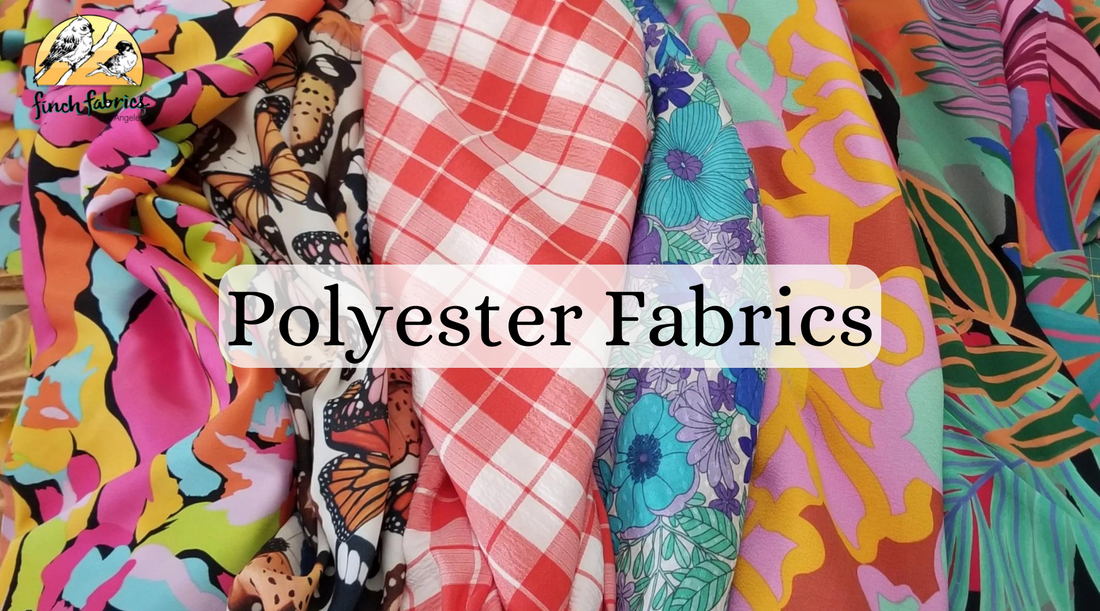
All About Polyester Fabrics
Share

We know you’ve seen them, and maybe even wearing it right now. Polyester!
It is one of the most versatile and durable fabrics out there.
So, if you are like me, and enjoy learning about the fibers that create such beautiful makes, then read on to explore what polyester actually is. This blog post will explore some of the most common types of polyester fabrics, tips on washing and caring for polyester fabric or clothing, and some handy guidelines on how to cut and sew with it.

What is Polyester Fabric?
Polyester is a man-made, synthetic fabric derived from petroleum. It was first introduced in the 1940s and has since become one of the most popular fabrics worldwide due to its durability, and ability to resist shrinkage and stretching.
Types of Polyester Fabric
There are various types of polyester fabrics available, each with its unique properties. Some common types include:

Satin Polyester
Satin Polyester is a type of polyester that has been woven in a specific way to create a glossy, smooth surface. It's often used in formal wear, bedding, and upholstery for its luxurious look and feel.

Crepe Polyester
Crepe Polyester is a type of polyester that has a distinctive crisp, crimped appearance. The fabric is woven in a way that creates a textured surface with a slightly wrinkled look. It's often used in dresses, skirts, and blouses for its elegant drape and slightly stretchy nature.

Georgette Polyester
Georgette Polyester is a type of polyester that is lightweight and semi-sheer with a dull finish. It is known for its crinkly surface, which is created by alternating S- and Z-twist yarns in both warp and weft. Georgette Polyester is perfect for blouses, dresses, and flowing gowns due to its elegant drape.
Other types of Polyester include Microfiber, Polyester Fleece,Tricot, Jersey, Double Knit, and Chiffon polyester fabrics, each offering different textures and uses.
How to Wash Polyester Fabric
Polyester is relatively easy to care for. It can safely be machine washed and dried, but when it comes to RTW garments, always check the care instructions before washing, as designers tend to combine textiles when creating.
When washing, use warm water and choose a regular cycle with a cool down or permanent press finish to prevent wrinkles. Avoid using bleach as it can damage the fibers. For drying, tumble dry low or hang to dry. Ironing polyester should be done on a low-heat setting to avoid damaging the fabric. Test a scrap to determine if you also need a press cloth to prevent shine.

How to Cut Polyester Fabric
When cutting polyester fabric, it's important to use sharp scissors to prevent snagging and fraying. Using a rotary cutter can also provide more of a clean cut, but just be sure to have a lint roller handy as the fabric can still leave frayed pieces on your cutting mat. Using a lint roller to grab up any residue fabric is a lifesaver. Polyester does not crease as easily as other fabrics, so using a fabric marker for pattern markings can be helpful.
How to Sew Polyester Fabric
Sewing with polyester can be a bit tricky because of its slippery nature, but tools like basting glue or sewing clips can help when prepping pattern pieces that need to be sewn together.
Use an appropriate needle, either a ballpoint for knits or universal for wovens. A new needle is recommended for each polyester project.
How to Care for Polyester Garments
Continue to wash and dry completed polyester garments in the same way you prepped the fabric. One advantage of polyester is its longevity and ability to look the same wash after wash.

Sew with Stephanie Evie Top
Pattern Suggestions for Polyester
VikiSews Joslyn blouse (satin polyester)
McCall's 7845 skirt (crepe polyester)
Sew with Stephanie Evie Top (georgette polyester)
